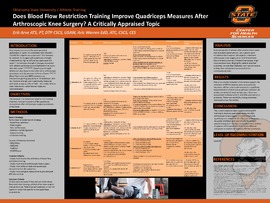| dc.contributor.author | Arve, Erik | |
| dc.contributor.author | Warren, Aric | |
| dc.date.accessioned | 2020-04-14T16:12:37Z | |
| dc.date.available | 2020-04-14T16:12:37Z | |
| dc.date.issued | 2019-02-22 | |
| dc.identifier | ouhd_arve_doesblood_2019 | |
| dc.identifier.citation | Arve, E., & Warren, A. (2019, Feb. 22). Does blood flow restriction training improve quadriceps measures after arthroscopic knee surgery? A critically appraised topic. Poster presented on Research Day at the Oklahoma State University Center for Health Sciences, Tulsa, OK. | |
| dc.identifier.uri | https://hdl.handle.net/11244/323868 | |
| dc.description.abstract | Introduction: Knee injuries are one of the most prevalent pathologies in sport. It is estimated that 100,000 - 250,000 ACL injuries occur per year3. It is common for patients to struggle with quadriceps strength impairment as high as 18% at two years post ACL repair11. Quadriceps strength is strongly associated with athletic performance and likelihood of re-injury after ACL repair4,5,10,12,13,19. Quadriceps strength deficits are also documented after other arthroscopic procedures and the presence of knee effusion 2,8,14,18. Blood flow restriction (BFR) training is an intervention gaining popularity in rehabilitation. BFR can improve strength and hypertrophy measures with loads as low as 20% of 1RM1. This makes BFR an ideal intervention when heavier loads are contraindicated. | |
| dc.description.abstract | Research Question: To determine if BFR improves relevant measures of the quadriceps after arthroscopic knee surgery. | |
| dc.description.abstract | Study Design: Critically Appraised Topic | |
| dc.description.abstract | Methods: An online search was performed using the following terms; "blood flow restriction," "knee surgery," "knee arthroscopy," "anterior cruciate ligament," "kaatsu training," and "occlusion training." | |
| dc.description.abstract | Results: Five of six articles included in this review support the utilization of BFR to improve post-op quadriceps measures. All five articles demonstrated a significant improvement in at least one quadriceps outcome. All studies consisted of small sample sizes, there was inconsistent initiation of BFR, and little consistency in protocols. There was variability among outcomes measured across the studies. | |
| dc.description.abstract | Conclusion: There is low level evidence that BFR should be included to improve quadriceps following arthroscopic knee surgery. More high quality studies are needed to make stronger recommendations. | |
| dc.format | application/pdf | |
| dc.language | en_US | |
| dc.publisher | Oklahoma State University Center for Health Sciences | |
| dc.rights | The author(s) retain the copyright or have the right to deposit the item giving the Oklahoma State University Library a limited, non-exclusive right to share this material in its institutional repository. Contact Digital Resources and Discovery Services at lib-dls@okstate.edu or 405-744-9161 for the permission policy on the use, reproduction or distribution of this material. | |
| dc.title | Does blood flow restriction training improve quadriceps measures after arthroscopic knee surgery? A critically appraised topic | |
| osu.filename | ouhd_arve_doesblood_2019.pdf | |
| dc.type.genre | Presentation | |
| dc.type.material | Text | |
